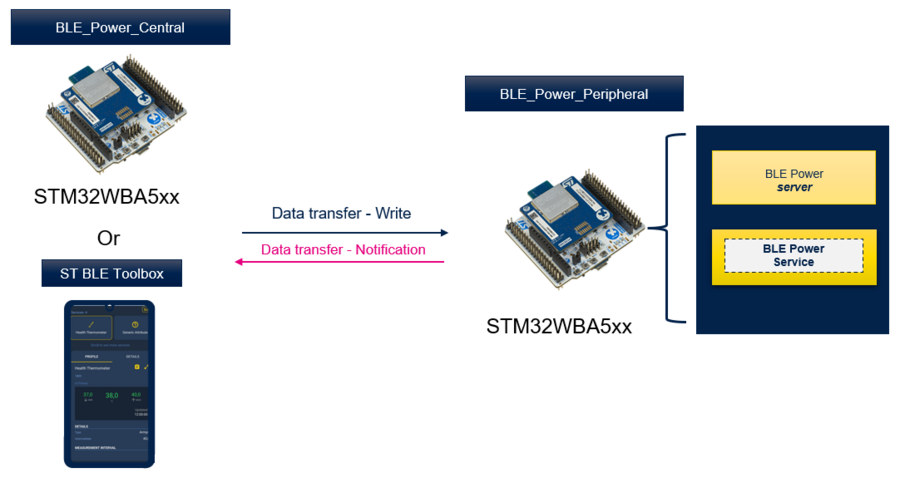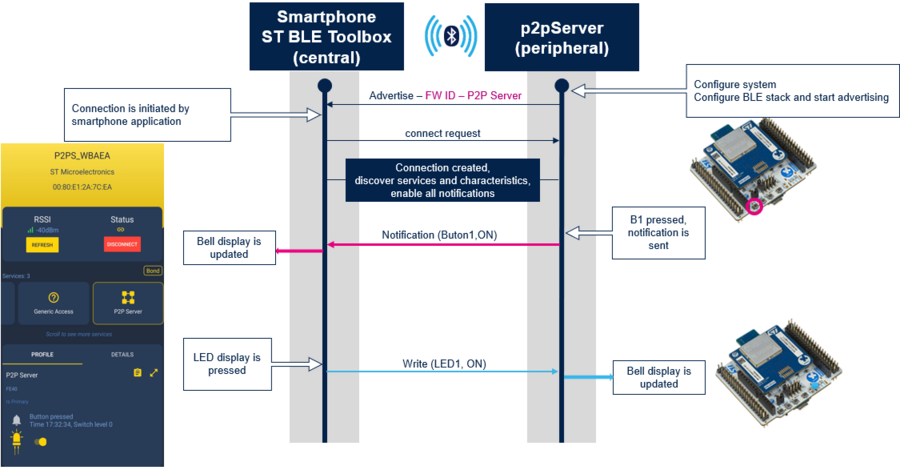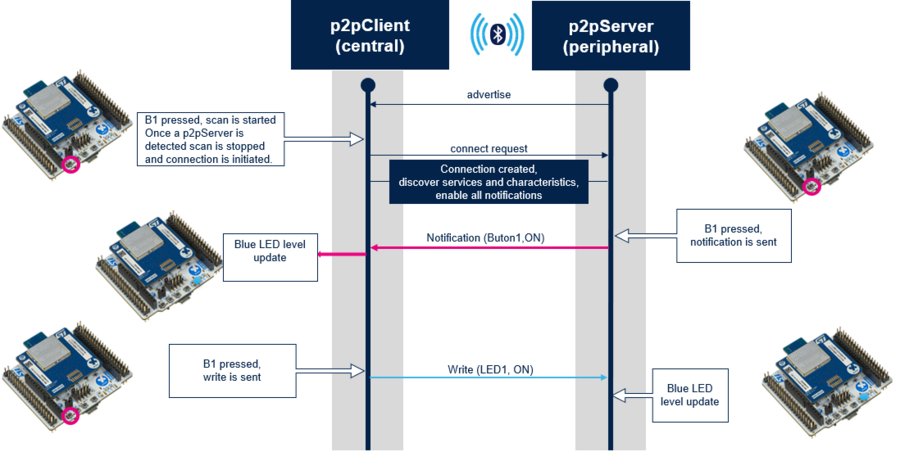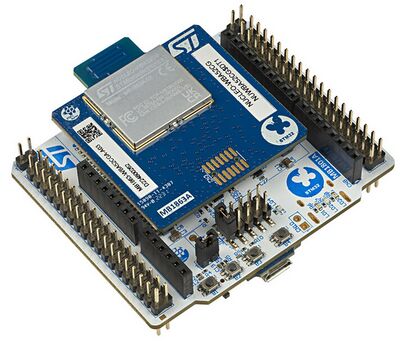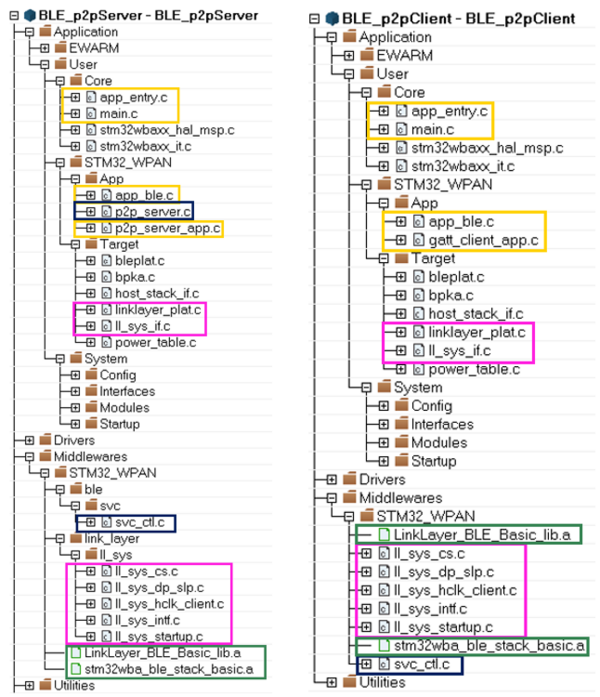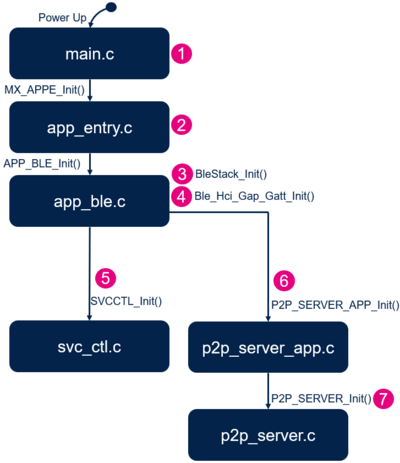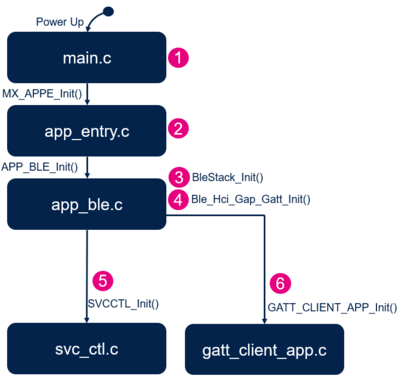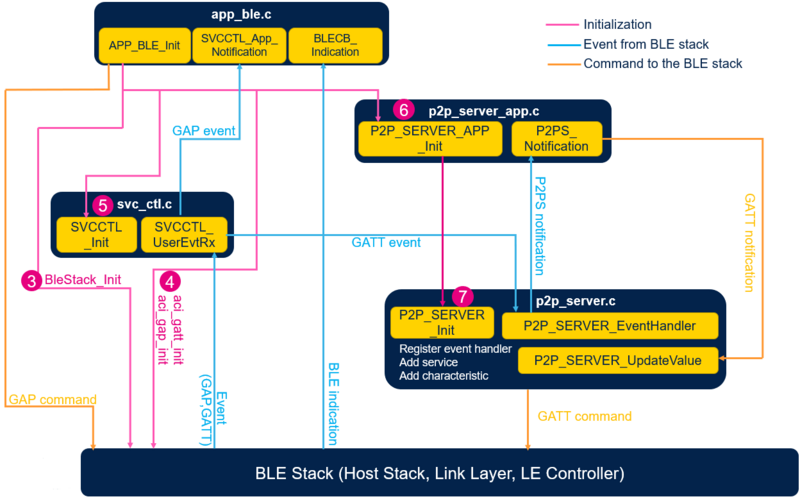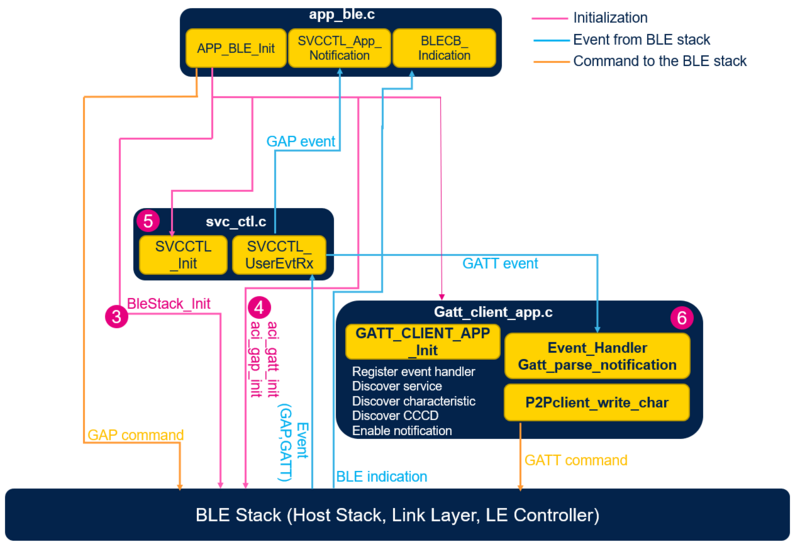1. Peer to Peer Profile
The Peer to Peer Profile is a Generic Attribute Profile (GATT) based low-energy profile defined by STMicroelectronics with proprietary UUIDs(128 bits)
The Peer to Peer Profile, widely used for direct connection, defines the communication between a GATT-server of a Peer to Peer Server device, and a GATT-client Collector device, such as a smartphone, STM32WBA Peer to Peer Client or Peer to Peer Router devices.
- The Peer to Peer Server:
- Contains the P2P Service, which expose two characteristics (Notification & Write) in order to create a bi-direction data communication.
- Is the GATT server.
- The Collector:
- Accesses the information exposed by Peer to Peer Server, controls it with the Write characteristics, receives Notification from it.
- Is the GATT client.
This wiki page is the description of the Peer to Peer Server and Peer to Peer Client projects provided within the STM32CubeWBA MCU Package[1]
Follow this "link" for Peer to Peer Router project explanation.
| Bluetooth® LE Peer to Peer Profile & STM32WBA |
|---|
1.1. STM32WBA Peer to Peer Server application
The table below describes the structure of Peer to Peer service:
| Bluetooth® LE Peer to Peer Service specification | ||||||||||||||||||||
|---|---|---|---|---|---|---|---|---|---|---|---|---|---|---|---|---|---|---|---|---|
|
Peer To Peer Server is exported as a Service
- LED characteristic:
- Used to control LED1 (Blue) on STM32WBA platform by remote device .
| Peer to Peer Service - LED Characteristic | |||||||||
|---|---|---|---|---|---|---|---|---|---|
|
- SWITCH Characteristic:
- Used to switch LED or Lamp on Collector device.
| Peer to Peer Service - SWITCH Characteristic | |||||||||
|---|---|---|---|---|---|---|---|---|---|
|
| Example of flow diagram between STM32WBA & ST BLE Toolbox |
|---|
At start up, Peer To Peer Server application starts Advertising including the Manufacturer Advertising Elements as described below:
| 0 | 1 | 2-3 | 4 | 5 | 6 | 7 | 8 | 9 | 10-15 | |
|---|---|---|---|---|---|---|---|---|---|---|
| Length | Manufacturer ID | Company | BlueSTSDK Version | Device ID | Firmware ID | Option 1 | Option 2 | Option 3 | Device Address | |
| P2P Server | 0x0F | 0xFF | 0x0030 STMicro | 0x02 | 0x8B Nucleo-WBA | 0x83 | 0x00 | 0x00 | 0x00 | 0x08E12Axxxx |
Advertising is stopped after 30s, pressing B1 restart it.
1.2. STM32WBA Peer to Peer Client application
It acts as a Central device with the support of GATT Client Layer.
At start up, by pressing B1 button, Peer To Peer Client application:
- Starts scanning to detect Peer To Peer Sever application by filtering the Firmware ID of the STMicroelectronics Manufacturer advertising data
- Stops Scanning once P2P server detected
- Connects to the P2P Server to establish the connection.
- Discovers GATT Service & Characteristics of the P2P server
- Enable all GATT server notification characteristics
Once connected, the Peer To Peer Client application:
- by pressing B1 button, write a message to toggle the Blue LED of the P2P Server
- Receive notification to toggle the on board Blue LED from remote P2P Server Application.
| Example of flow diagram between STM32WBA P2P Server & P2P Client |
|---|
1.3. On board buttons configuration
| P2P Applications Nucleo-WBA buttons configuration | ||||||||||||||||||||||||
|---|---|---|---|---|---|---|---|---|---|---|---|---|---|---|---|---|---|---|---|---|---|---|---|---|
|
2. Requirements
2.1. Software and system requirements
The software required are the following (minimum IDEs version):
- IAR Embedded Workbench for ARM (EWARM) toolchain V??
- RealView Microcontroller Development Kit (MDK-ARM) toolchain V??
- STM32CubeIDE toolchain V?? [2].
Programmer:
- STM32CubeProgrammer[3] : To flash the board with an already generated binary
2.2. Hardware requirements
NUCLEO-WBA5 [4] is necessary to install the application.
| Hardware platform illustration |
|---|
|
|
2.3. Collector applications compatible
The STM32CubeWBA Health Thermometer Sensor project is compatible with the following collector:
3. STM32WBA P2P Server & P2P Client examples description
3.1. Project directory
The "BLE_p2pServer" & "BLE_p2pClient"applications are available by downloading STM32CubeWBA MCU Package[5]. LINK TO UPDATE
| P2P Server & Client projects directory |
|---|
3.2. Project description
3.2.1. Structure
Software project structure with the most important parts:
| P2P Server / Client project structure |
|---|
|
WARNING: Do not modify the files in Middlewares folder |
3.2.2. Application initialization
The different steps of the application initialization are described below:
| P2P Server project initialization |
|---|
| P2P Client project initialization |
3.2.3. GAP and GATT initialization and interaction
and ![]() The Bluetooth LE P2P Server application initialization is done within app_ble.c
The Bluetooth LE P2P Server application initialization is done within app_ble.c
- Initialize the BLE stack - initialize the device as peripheral - configure and start advertising: ADV parameters, local name, UUID - APP_BLE_init()
- Call the services controller initialization SVCCTL_Init() - svc_ctl.c
- Manage the GAP event - SVCCTL_App_Notification() - svc_ctl.c
- HCI_LE_CONNECTION_COMPLETE - provides information of the connection interval, slave latency, supervision timeout
- HCI_LE_CONNECTION_UPDATE_COMPLETE- provides the new information of the connection
- HCI_DISCONNECTION_COMPLETE - informs the application about the link disconnection and the reason
The Services management is done by the service controller, svc_ctl.c
- Initialize the number of registered handler - SVCCTL_Init()
- Manage events - SVCCTL_UserEvtRx()- from the BLE Host Stack and redirect them to the gap event handler - SVCCTL_App_Notification()
The application level of the P2P Server is done with p2p_server_app.c:
- Initialization of the services:
- P2P Server Service - P2P_SERVER_Init() - p2p_server.c
- Initialization of the context of the application
- Receive notification from the P2P Server Service - P2P_SERVER_Notification()
- When P2P_SERVER_LED_C_WRITE_NO_RESP_EVT event is received from the P2P Client, the blue LED is toggled.
- P2P_SERVER_Switch_c_SendNotification() function is called on Button 1 press, to notify the P2P Client:
- P2P_SERVER_UpdateValue() is called with the notification data - p2p_server.c
The Custom P2P Server Service p2p_server.c manages the specification of the service:
- Service Init - P2P_SERVER_Init()
- Register P2P Server Event Handle to Service Controller - SVCCTL_RegisterSvcHandler();
- Initialize Service UUID – add P2P Server service as Primary services
- Initialize LED_C characteristic
- Initialize SWITCH_C characteristic
- Manage the GATT event from BLE Stack - P2P_SERVER_EventHandler()
- ACI_GATT_ATTRIBUTE_MODIFIED_VSEVT_CODE
- Reception of an attribute modification - LED C Value : ON or OFF Indication
- Notify application of the Measurement Notification - P2P_SERVER_Notification(P2P_SERVER_LED_C_WRITE_NO_RESP_EVT)
- Reception of an attribute modification - LED C Value : ON or OFF Indication
- ACI_GATT_ATTRIBUTE_MODIFIED_VSEVT_CODE
| P2P Server software module interaction |
|---|
and ![]() The Bluetooth LE P2P Client application initialization is done within app_ble.c
The Bluetooth LE P2P Client application initialization is done within app_ble.c
- Initialize the BLE stack - initialize the device as peripheral - configure and start advertising: ADV parameters, local name, UUID - APP_BLE_init()
- Call the services controller initialization SVCCTL_Init() - svc_ctl.c
- Manage the GAP event - SVCCTL_App_Notification() - svc_ctl.c
- HCI_LE_CONNECTION_COMPLETE - provides information of the connection interval, slave latency, supervision timeout
- HCI_LE_CONNECTION_UPDATE_COMPLETE- provides the new information of the connection
- HCI_DISCONNECTION_COMPLETE - informs the application about the link disconnection and the reason
The Services management is done by the service controller, svc_ctl.c
- Initialize the number of registered handler - SVCCTL_Init()
- Manage events - SVCCTL_UserEvtRx()- from the BLE Host Stack and redirect them to the gap event handler - SVCCTL_App_Notification()
The application level of the P2P Client is done with gatt_client_app.c:
- Initialization of the application context
- Register Event Handler to BLE Controller - SVCCTL_RegisterCltHandler();
- Initialize LED data level and selection
- Manage the GATT event from BLE Stack - gatt_parse_notification()
- ACI_GATT_NOTIFICATION_VSEVT_CODE
- When the notification event is received from the P2P Server, the blue LED is toggled - gatt_Notification()
- ACI_GATT_NOTIFICATION_VSEVT_CODE
- Write characteristic to P2P Server (LED toggling) - P2Pclient_write_char() - by pressing Button 1 while connected.
| P2P Client software module interaction |
|---|
3.3. Build and install
Follow the steps described in Bluetooth® LE Build and Install Application page, applying them for STM32WBA BLE_p2pServer and BLE_p2pClient projects
3.4. How to use
Once the BLE P2P Server application is installed on the STM32WBA platform, launch ST BLE ToolBox smartphone application.
Then, scan and connect the device called p2pS_XX (where XX is replaced by the last byte of the BD address) to the application.
Once the Bluetooth® LE connection is established and the notification enabled by the smartphone (by clicking on P2P Server icon):
- LED_C value can be modified by clicking on the LED button on smartphone interface, the blue LED of the Nucleo board is switched On/Off accordingly.
- Pressing SW1 button on the board while connected send a SWITCH_C notification to the smartphone and the switch level is updated on the smartphone interface.
3.5. UART debug trace
Thanks to the debug log via UART interface LINK TO UPDATE?, it is possible to trace the application project.
To enable the traces within the project, enable them within app_conf.h as described below:
/**
* Enable or Disable traces in application
*/
#define CFG_DEBUG_APP_TRACE (1)
| P2P Server - Initialization phase | Connected Phase and LED On notification |
|---|---|
==>> Start Ble_Hci_Gap_Gatt_Init function
Success: hci_reset command
Success: aci_hal_write_config_data command - CONFIG_DATA_PUBADDR_OFFSET
Public Bluetooth Address: 00:80:e1:2a:7c:ea
Success: aci_hal_write_config_data command - CONFIG_DATA_IR_OFFSET
Success: aci_hal_write_config_data command - CONFIG_DATA_ER_OFFSET
Success: aci_hal_set_tx_power_level command
Success: aci_gatt_init command
Success: aci_gap_init command
Success: aci_gatt_update_char_value - Device Name
Success: aci_gatt_update_char_value - Appearance
Success: hci_le_set_default_phy command
Success: aci_gap_set_io_capability command
Success: aci_gap_set_authentication_requirement command
Success: aci_gap_configure_whitelist command
==>> End Ble_Hci_Gap_Gatt_Init function
Services and Characteristics creation
Success: aci_gatt_add_service command: P2P_Server
Success: aci_gatt_add_char command : LED_C
Success: aci_gatt_add_char command : SWITCH_C
End of Services and Characteristics creation
Success: aci_hal_set_radio_activity_mask command
==>> aci_gap_set_discoverable - Success
==>> Success: Start Advertising
|
>>== HCI_LE_CONNECTION_COMPLETE_SUBEVT_CODE - Connection handle: 0x0001
- Connection established with @:7d:64:80:ff:2e:4f
- Connection Interval: 48.75 ms
- Connection latency: 0
- Supervision Timeout: 5000 ms
>>== HCI_LE_CONNECTION_UPDATE_COMPLETE_SUBEVT_CODE
- Connection Interval: 7.50 ms
- Connection latency: 0
- Supervision Timeout: 5000 ms
>>== HCI_LE_CONNECTION_UPDATE_COMPLETE_SUBEVT_CODE
- Connection Interval: 48.75 ms
- Connection latency: 0
- Supervision Timeout: 5000 ms
-- P2P APPLICATION SERVER : NOTIFICATION ENABLED
-- GATT : LED CONFIGURATION RECEIVED
-- P2P APPLICATION SERVER : LED1 ON
|
4. References
